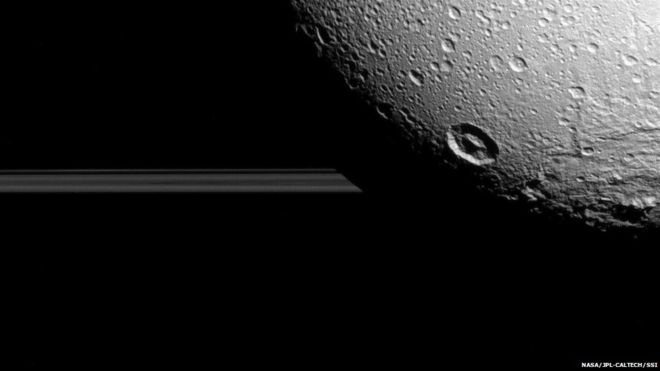
The Cassini mission to Saturn has returned its final close-up images of the gas giant's Dione moon.
The probe passed within 500km of the pockmarked surface on Monday - its fifth such encounter in the spacecraft's 11-year tour of the ringed planet.
The Cassini mission to Saturn has returned its final close-up images of the gas giant's Dione moon.
The probe passed within 500km of the pockmarked surface on Monday - its fifth such encounter in the spacecraft's 11-year tour of the ringed planet.
Cassini is now engaged in a series of observational "lasts".
And in 2017 it will put itself on a destructive dive into Saturn's atmosphere.
"I am moved, as I know everyone else is, looking at these exquisite images of Dione's surface and crescent, and knowing that they are the last we will see of this far-off world for a very long time to come," said Carolyn Porco, who leads the imaging team on the mission.
"Right down to the last, Cassini has faithfully delivered another extraordinary set of riches. How lucky we have been."
The closest ever approach to Dione was in 2011, when the US, European and Italian space agency mission swept just 100km above the moon.
Dione has a diameter of 1,122km, making it the fourth largest of Saturn's 62 moons. It has an icy exterior and a rocky interior.
Cassini has detected a wispy oxygen atmosphere at the world, and has also seen signs that it may still be active, with what appear to be regions on its surface that have been altered by internal processes.
Next year, Cassini will begin a series of manoeuvres to put itself in orbits that take it high above, and through, Saturn's rings.
Then, in 2017, once the probe's fuel has all but run out, ground controllers will command the spacecraft to plunge into the planet's atmosphere, where it will be destroyed.
As Cassini hurtles towards Saturn, it will become incredibly hot, will melt and ultimately will be crushed by huge pressures.
The mission is being disposed of in this way to be sure there is no possibility that debris from Cassini can one day land on Enceladus and Titan. These moons have been talked of as candidates for extraterrestrial life, and scientists would not want them contaminated by any Earth microbes that might still be on the probe - however unlikely that might be.
Cassini looks back at Dione as
it heads away from the encounter
The coming months will see Cassini make final, farewell passes of a number of moons.
Referring to Monday's flyby of Dione, Dr Porco said: "Consider this the start of The Long Goodbye."
No missions are presently in preparation to re-visit the Saturnian system.
Those outer-planet ventures that are being worked on will go to Jupiter.
America has its Juno probe arriving at the gas giant next year, to be followed by Europe's Juice satellite in the 2030s.

 Previous page
Previous page Back to top
Back to top







